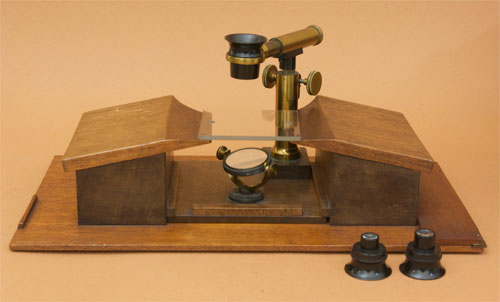 |
|||||
 |
 |
||||
 |
|||||
 |
 |
||||
Théodore Chauvel Dissecting Microscope (No. 344) |
|||||||
 |
Age: c1885 Made by: Théodore Chavel Made in: France |
||||||
 |
|||||||
|
Imaging
|
|||||||
|
This is a Vérick-type dissecting microscope made by Théodore (Theophile-Narcisse) Chauvel (1831–1909). It consists of a fruit wood frame that is inclined to allow one's arms to rest while dissection. In the center is the mounted mirror and objective support. The mirror is original and is centrally located for transmitted light illumination of the sample. The microscope is mounted to the back corner of the removable surface. It consists of a cylindrical pillar with rack & pinion focus. Attached to the top is the horizontal objective support. It can be translated via a knurled knob at the end of the support. There are three objectives, each mounted in a turned wooden holder. They can be placed into the circular objective mount at the end of the cantilever The glass sample stage is not original as its mounting holes do not match with the microscope body. On one side of the wooden body is a hinged extension. The only accessories are several boxes of coverslips one of which was made by Nachet. Imaging is quite good, although illumination can be a problem with opaque samples. This microscope is a unique microscope made by a demanding and well-known French amateur of microscopy. The microscope is 35x21x13 cm. Included with this instrument is a handwritten note on a tobacco box: "verres de microscope. doublets du microscope construit par Th. Chauvel”. (lenses for microscope. Doublets for the microscope built by Th. Chauvel"). Written on the bottom of the microscope is "Th. Chauvel fecit" and two "modification" dates 1880 and 1882. Théodor Chauvel (1831–1909) was a pioneer of the French etching revival. Along with this profession, Chauvel was an enthusiastic amateur microscopist. In the book 19th Century Engravers (1886, Brascassat - Cheret, Paris) Henri Beraldi wrote the following about Théodore Chauvel: A particularity about Chauvel: He is bitten by a passion, and this passion is neither lithography, nor etching, nor painting: it is micrography. His workshop is an arsenal of microscopes of all models, advanced objectives and everything that goes with it. Anyone who, even if only once in their life, has looked through a microscope to see a spider nail or a diatom, will understand this passion. Thanks to Alexandre Piffault, Le Zograscope for the detailed description of the Chauvel microscope. Microscope featured 03/2024 |
|||||||